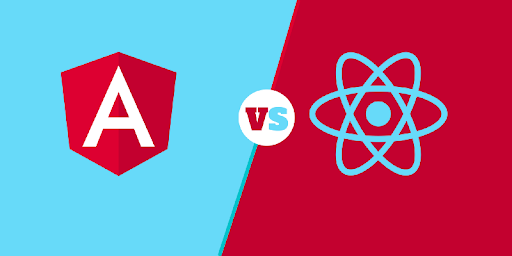React v/s Angular: Which JS Framework should you go for?
Let me ask you a question, as a developer, what’s your favorite or most commonly used computer language?
Well, I guess most of you picked up Javascript (JS). That’s what almost every study and research I came across said. In fact, according to StackOverflow’s 2021 Developer Survey, JavaScript currently stands as the most commonly-used language in the world with almost 65% of all developers using it.
Most developers love to build their applications using Javascript and for good reason. It is not only easy to learn and use, but also is most widely used across websites and applications. Since it is ubiquitous, anywhere you get stuck, you have support from countless communities, courses, and avenues available online.
While JS may be the undisputed champion when it comes to coding languages, we don’t have a matching fit for Javascript frameworks. When it comes to JS frameworks, we have two players giving neck-to-neck competition to one another. Angular and ReactJS are the leading choices for any developer when it comes to JS. However, what most developers struggle with is making a choice between the two.
First things first, there’s no universally correct answer for that. It all depends on what your needs are. Both of these frameworks can be used to build web applications and mobile applications, and both have their advantages and disadvantages. Both can be relied upon to help you build a fantastic application. Picking the one you should go for depends entirely upon you. You just need to figure out the one that would suit you the best. And I can help you there. You just need to understand what each of these has in store for you and then pick your best bet based on what you are looking for.
Before jumping on to the difference between the two Javascript frameworks, let’s talk a little about them and what they are.
What is React?
React is a free and open-source Javascript library developed by Facebook which allows you to build UI components.
This library mostly deals with views and is not a full-fledged framework. It makes the code much easier to understand. The use of React along with a few other libraries can turn it into a complete framework. It was created by Jordan Walke in 2011 and was open-sourced in May 2013.
What is Angular?
Angular is a Typescript-based free and open-source web application framework led by Google in 2010 for developing dynamic web applications.
This is a full-fledged framework that helps in developing dynamic, single-page web applications and also supports programming structure.
That’s the crux of what these two frameworks are. Now is the time to deep dive into what they have in store for you and how that differs.
10 Key Differences between Angular and React
So far, we know that Angular is a complete structural framework while React is a Javascript library to build UI components and that both are used for developing dynamic web applications. That’s the basic difference between the two. Is that all? Of course, not. Here are different features and parameters that the two frameworks differ on.
Development Model
One of the first differences between the two frameworks is in the development model. Angular is based on the MVC or Model-View-Controller model while React is not exactly that. Let me explain.
While these two are not mutually exclusive or contrasting models, they are quite different practices. In MVC you divide your application into three components and add updates to each depending on the update feature. The Model component is the ringmaster administering your app data, the View component takes care of the data that your user is going to use while the Controller is the bridge between the Model and the View components making sure what the user sees as the right usability.
On the other hand, React is a rendering library and ideally just takes care of the View layer. It doesn’t have a central Controller as an orchestrator/router as MVC architectures on the backend typically have come to have.
Libraries
Cutting to the chase here, React can be used with other libraries whereas Angular is a full-fledged framework, works as a complete solution in itself. So, if you are building the project in React, you’ll need multiple supporting tools such as Redux (for state management), Babel (for converting JSX into JavaScript), and Webpack (a standard module bundler). Of course, this lets you work with tools that you’re more comfortable with and suit your development requirements. On the other hand, we have Angular, which is a pure full-fledged framework and comes with many out-of-the-box inclusive features like RxJS (for reactive programming to JS), Angular CLI (a powerful command-line interface), and Angular Universal (used for server-side rendering). The good part here would be that you would probably find everything you need under one roof and need not hunt for more.
Learning Curve
This one’s pretty straightforward. Any developer who’s worked on both React and Angular knows for a fact that React is easier to learn as compared to Angular, and Angular is not easy for beginners. So, if you are a newbie in development, React is your best bet. You need zero prior knowledge to get started with React and you would be able to get going with the basics very soon.
Installation Time
This one too is an open secret amongst developers that even though React is easier to learn, it does give the developers a run for their money when it comes to set up. Angular, on the other hand, is much easier to set up.
Having said that, while Installation time is a key factor in choosing a tool, don’t make it a deciding factor as that’s a one-time hassle that you need to worry about and shouldn’t impact how feasible a tool is for you.
Testing and Debugging
Much like what I discussed previously with libraries, React would need a set of tools to perform testing and debugging, whereas in Angular it is possible with a single tool. Having said that, you need to know the Angular tools while in React you can use a testing tool that you are comfortable with.
Application Type
Now, this is a major deciding factor when it comes to choosing between React and Angular. React is best suited for making frontends of quick and modern web applications, whereas Angular is ideal when you want to develop large-scale feature-rich applications.
Performance and DOM
Another key difference between the two frameworks is that React uses Virtual DOM, while Angular operates on Real DOM. This becomes key in how you update your application. When it comes to Real DOM (that Angular operates with), the entire tree structure of your application gets updated with each change that you make. Therefore the complete tree is updated each time. However, the Virtual DOM model is focused more on speed and making changes to different components of your application faster. To do that, it essentially records the changes in a Virtual DOM, compares them with the existing Real DOM, and only renders the parts which have updates instead of rendering the whole thing all over again. This lets you be more flexible with the development and iterate faster. In the case of Angular, the real DOM makes its apps slower when working with a ton of data requests.
Companies
Not that I think this should impact your decision majorly, but I thought I’d quickly mention the companies that use these frameworks.
React is used by Facebook, Airbnb, Uber, Netflix, Instagram, WhatsApp, Dropbox, etc, while Angular is used by Google, Nike, Forbes, Upwork, Paypal, Telegram, etc. You may want to check out their frontends to maybe decide which one you like more.
My Take: Which one should you go for?
There’s no denying the fact that both React and Angular are amazing tools/frameworks for frontend development. Not just that, there’s a strong community behind both of them working towards making them better each passing day. So, whichever you go for, it would be a good deal.
Having said that, I personally feel that for someone who’s new to programming, React would be a safer bet. Not just because it’s easier to learn but also because it’s more flexible to experience with. As for experienced professionals, they know which one they’re more comfortable with and which one works best for the project at hand. So, they can choose accordingly.
Team Udgama
- 10 backend mistakes (and their fixes) you must avoid as a Backend Developer
- 5 Frontend Trends You Can’t Ignore in 2022










